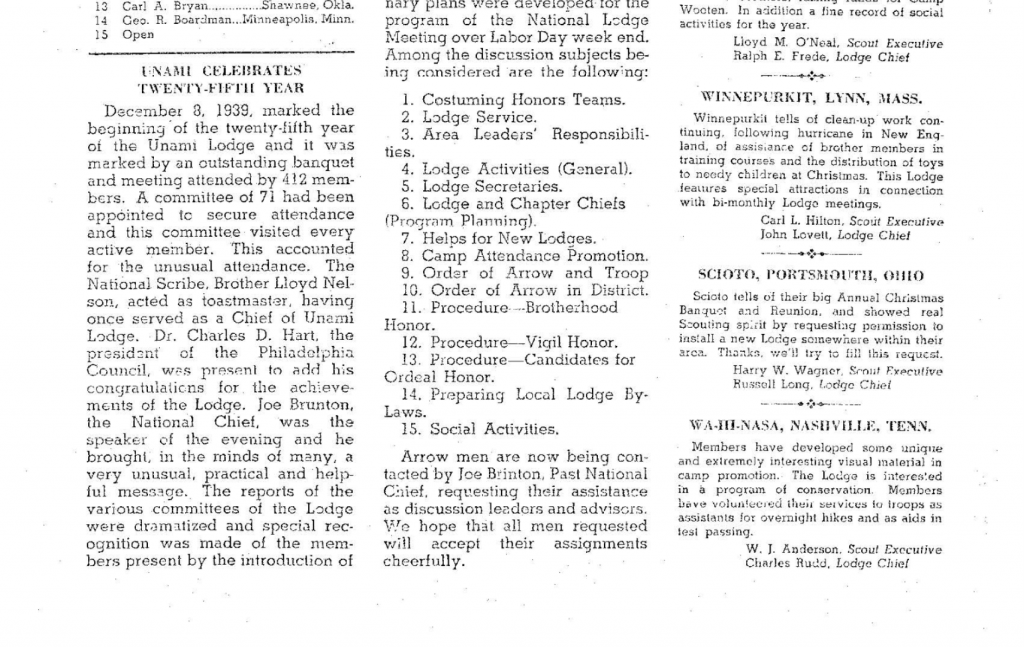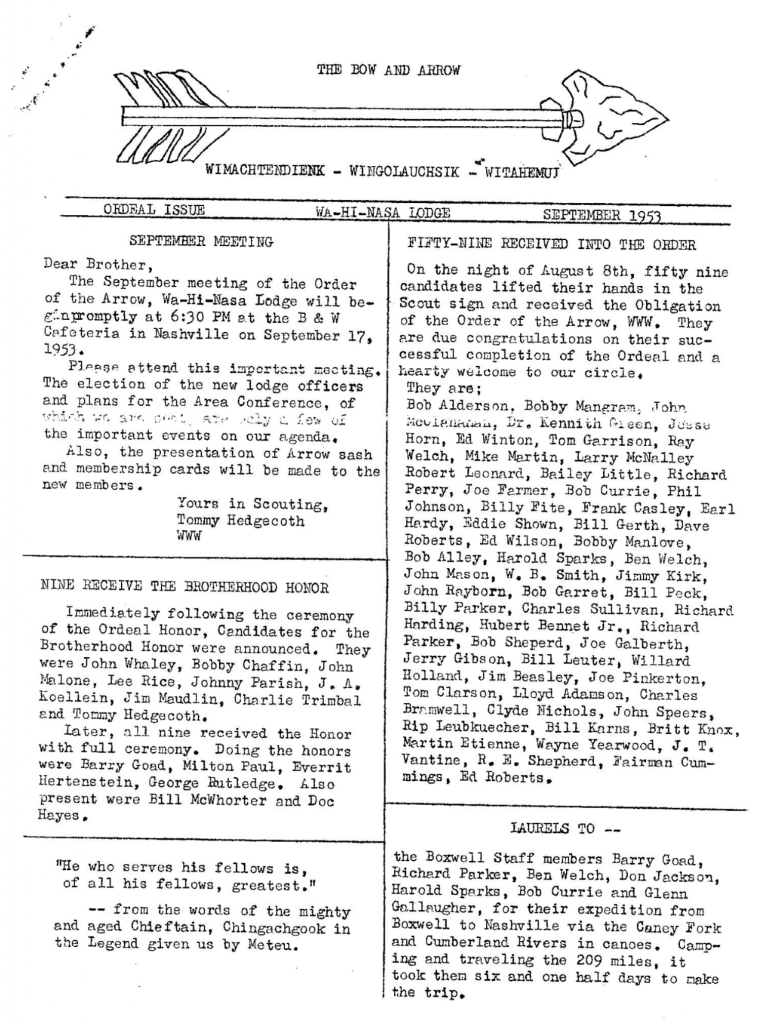The Early Years (1939-1958)
Return to the main History page
Roy Shaub served out the remainder of 1938 as Lodge Chief and was replaced in 1939 by Don McMillan. When McMillan’s term was complete, he moved to that of chairman of the social committee. He and Kilgore attended the 1940 Grand Lodge Meeting at Camp Twin Echo in Pennsylvania. It was in 1940, under Chief Charles Rudd, that Wa-Hi-Nasa really started going. This was marked by the beginning of the Wa-Hi-Nasa newsletter. At that time, the letter had no name and it only cost one dollar to print out all the copies for the forty members of the lodge. The original newsletter discussed renovation projects at Camp Boxwell, still located at the Narrows of the Harpeth, and featured an Arrowman Spotlight of Don McMillan. The early lodge meetings were held typically were held quarterly and were held away from camp. These meeting intended for the entire lodge were held at the B & W Cafeteria on Murfreesboro Road in Nashville, while the lodge executive committee still held their separate meetings to prepare for the lodge business and the lodge meetings.

Also, in 1940 the distinguished Scouts L.G. Boxwell, Justin Potter, and E.E. Murrey were inducted into the OA. In the early days of the lodge, eligibility for membership consisted of 1) First Class rank, 2) being at least age 15, and 3) having attended at least 2 sessions of a large group encampment (e.g. summer camp). Though a person was elected by a camp the nomination of new members had to be approved by unanimous vote of the current OA members present during summer camp, which at that time was old Camp Boxwell (on the narrows of the Harpeth River). Later, more specific eligibility requirements were dictated by the National Lodge, allowing the non-members in each unit to begin electing candidates for membership from their own troop, as we do today.
The Wa-Hi-Nasa Lodge has always been built out of summer camp, so the lodge has always been one of the biggest supporters of camp and camp promotion. In 1940, The OA National Bulletin commented on a new and “extremely interesting” visual material for camp promotion that was created by our lodge. This refers to a 8 mm film that the lodge produced and copied with what is likely the first camp promotion video in the country. This video has been digitized and can be seen today. The article also mentions that the members volunteer to help troops on overnight hikes and as aids in test passing.

As time went on the lodge sought better ways to serve the camp that all of our members had in common. In 1945, the lodge spent several weekends to build a little over a half a mile road into camp over three camp work weekends. The lodge had also built a stone podium and created a rustic fence around the ceremony grounds. Then it was also noted in the National Bulletin, that the lodge still continued to help troop program and troop activities. The brotherhood was kept in fellowship with each other by holding social events like hay rides and cook outs for the members and their sweethearts.
As with any honor that people are elected into, there have always been questions of the reasons that a person was elected. One such funny story involved the camp cook in 1946. Walter Whittaker, the Camp Boxwell cook, was elected by unanimous vote as an honoree member of the OA. Some thought that it was only a bid by the members of Wa-Hi-Nasa to get a few extra rolls and bites of blackberry cobbler. Coach Anderson said “it’s just a case of brotherhood cheerfulness and service, the three things for which the OA stands.”
The lodge served the old Nashville Area Council not only in camp service, but also in sponsoring events like a spring camporee. The term of our first Scout Executive ended in 1947. After twenty seven faithful years Coach Anderson saw the lodge grew to the point that the annual spring camporee was continually sponsored by the Wa-Hi-Nasa Lodge. This event was held on a spring weekend at Percy Warner Park. This camporee boasted two hundred and twenty seven scouts from twenty eight troops in attendance. A letter from Joe Womack, Lodge Chief, to OA members (dated June 5, 1948), states that the majority of troops in the Nashville Area Council were new, and thus dependent on the older boy leadership that the OA could provide. This was just another of the legacy of the Wa-Hi-Nasa Lodge in support of our council.

Nineteen forty eight began a two year span that saw a lot of change in not only the Order of the Arrow but also in the Nashville Area Council. It was announced at the 1948 National Order of the Arrow Conference that the Order itself was full integrated into the BSA National structure, thus becoming THE camp society for the Boy Scouts of America. Becoming the national program also brought with it requiring the lodges to elect a youth lodge chief, although Wa-Hi-Nasa had been doing this for some time. Closer to home, Ward Akers was selected as the new Scout Executive for the Nashville Area Council and adapted a system of management that created 12 districts. Ward was also the beneficiary of seeing the acquisition of the property that would become the next Camp Boxwell.
The next year (1949) saw the first summer camp at the new Camp Boxwell at Rock Island. Although this site would only host summer camp for ten years, this piece of property is still a camping destination for many troops within Middle Tennessee. Many still know it as Rock Island and some know it as Camp Tubb or Charles E Parish Wilderness Reservation. This year also saw the Nashville Area Council changing names to the Middle Tennessee Council to better reflect the scouts that the council was now serving.
At the beginning of the 1950’s the lodge was headquartered in Old Camp Boxwell at Rock Island and had a registration under forty people. Because of this number of members, Wa-Hi-Nasa was not permitted to form chapters despite the request of Chief Barry Goad. Each year the lodge would hold only one Ordeal in one weekend in which the candidates would prepare for the opening of Boxwell. One member said that for both breakfast and lunch during his Ordeal he was given half-a-piece of stale bread and half-a-cup of a drink that looked “pretty much like dishwater”, but we all have our fish stories. Though the lodge was headquartered at Camp Boxwell there was not an OA lodge building at Old Camp Boxwell. The lodge instead used an at the time old shack as a meeting place. There are stories of this building with a hole in the middle where the floor had collapsed.
The Brotherhood Honor up until this time was bestowed upon individuals by vote of 50% or more of the active lodge members upon those who they felt upheld the principles of Brotherhood, Cheerfulness and Service. In 1949, the National Committee decided to have all sashes worn over the right shoulder. This ended the process of Ordeal (First Degree) members wearing a sash with a red arrow over the right shoulder and those with the second (Brotherhood) degree wearing the same sash over the left shoulder.

Lodge records show that Joe Womack, the 1948 lodge chief, became the lodge’s first Vigil Honor member in 1951. At that time, requirements for consideration to the Vigil Honor included three years of active Brotherhood membership. A January 1954 “Bow and Arrow” has an article by Dr. Goodman describing the three honors and list all those known to have gone through them. So in 1954 there were three Vigil Honor members and only 45 members who were active that had received the Brotherhood honor. In 1955 the requirements for Vigil were changed to two years as a brotherhood member to allow more youth to be eligible to receive the Vigil Honor. In 1958 the requirements were further changed to include that 50% of the new Vigil Honor members were to be youth members.
During the fifties the number of newly-elected members began to skyrocket. Camp Boxwell had a greater attendance than it does today, boasting eight weeks of summer camp, so in 1958 the lodge grew to 850 members. In 1954, the Wa-Hi-Nasa Lodge had enough members to implement the chapter program, each given its own number rather than a name. Chapters were organized along district lines but only three were up and running and all members were encouraged to join a chapter through the lodge publication “the Bow and Arrow.” Some of the chapters lacked official advisers, or any form of adult guidance. The Order of the Arrow, at that time, did not supply a handbook for advisers. The only source for a job description for advisers were located in the Order of the Arrow Handbook or the Ordeal pamphlets, which were extremely brief on the matter. This “Bow and Arrow” also talks about the first area conference that was hosted by the Wa-Hi-Nasa Lodge. The Area V-B conference was held at Montgomery Bell State Park on April 25th and 26th, 1954. This conference also held the first known Wa-Hi-Nasa member serving as Area Chief, Bill McWhorter.
As you can see by 1958 camp was growing strong and so was the lodge. This growth meant that a larger and more durable camp ground needed to be acquired. Identifying a piece of land in 1952 and working for 5 years until in 1957, the council acquired a $1 title to 528 acres of land from the US Army Corps of Engineers by a special act of Congress. This piece of property in LaGuardo, Tennessee is the shore line and base of what we now call our home, Boxwell Reservation. Yes, we would then gear up for a move to a new Boxwell and a new home of the Wa-Hi-Nasa Lodge.
